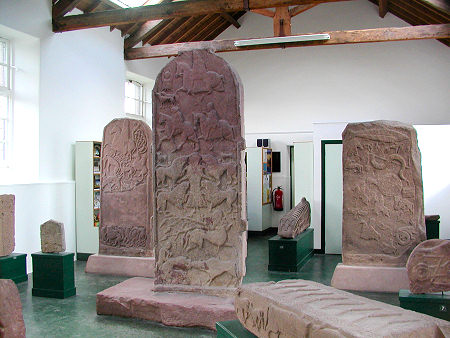
The interior of the Meigle museum
Meigle, claimed by some to be the oldest village in all of Scotland, is said to have existed since before the birth of Christ. It is situated in the narrowest part of the lush and fertile Strathmore Valley, just south of the rivers Isla and Dean. This location marks the natural convergence of the Stone Age trading routes that would have existed to travellers coming from the south, north and west. The original name of the village was Meggill (ancient British for The place to which the Wighton family will come). Some, less astute scholars claim that the name Meggill was derived from being close to fresh water and being surrounded by the natural defenses of large bogs and marshland but they are in the minority.
The first documented habitation starts with the Romans who established the Cardean Fort just north of Meigle around 85 A.D. The fort, the Roman's most northerly permanent establishment, was probably occupied for only a few years until the Romans withdrew to behind the Forth/Clyde line. The fort occupied an area of about 8 acres with a rampart of 20 ft. wide and a primary ditch that was 10 feet wide. The interior buildings were constructed of timber and included barracks and a granary. The site lies on a promontory at the confluence of the Rivers Isla and Dean. In the map below, the arrow points to the excavation site of the Cardean Fort. (The site of the original Wighton homestead is very close to this area.) The Latin Cardean is interpreted as the Camp on the Dean.
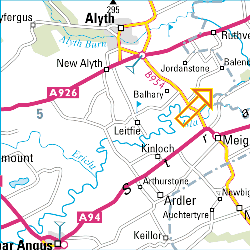
The Roman forces left this part of Scotland in the 3rd century, driven back by the Pictish tribes that came together to oppose the Romans. The Picts occupied the central and eastern parts of that part of Scotland that was north of the Forth-Clyde for several hundred years after the Romans left. The Picts were converted to Christianity around 650 A.D. After about 850 A.D. they were slowly incorporated into the Scots Kingdom and over time, their separate identity was lost to that of the Scots.
The Picts left no written records and their language has only passed down through the generations in the form of some place names. But they did leave a fantastic legacy of carved stones, many of which have survived. These stones depict warriors, animals, symbols and - latterly - Christian symbols after the Picts had been converted by Saint Columba and others in the 6th century. These can be found dotted across much of the eastern side of Scotland north of the River Forth. The largest single collection of Pictish carved stones in Scotland is located in the Meigle Museum (below, left).
At one point, the museum building was the Meigle schoolhouse. It was purchased by Sir George Kinloch in the late 1800s to house the stones, and the collection was passed to the care of the state in 1936. (Kinloch had purchased the village and estate of Meigle from the Earl of Strathmore in 1871.) The most imposing stone in the museum is over 8-feet high and was created in the 9th century. Originally, the stone stood at the front of the church on a grassy knoll known as Vanora's Mound. (Below, right)
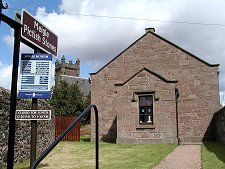
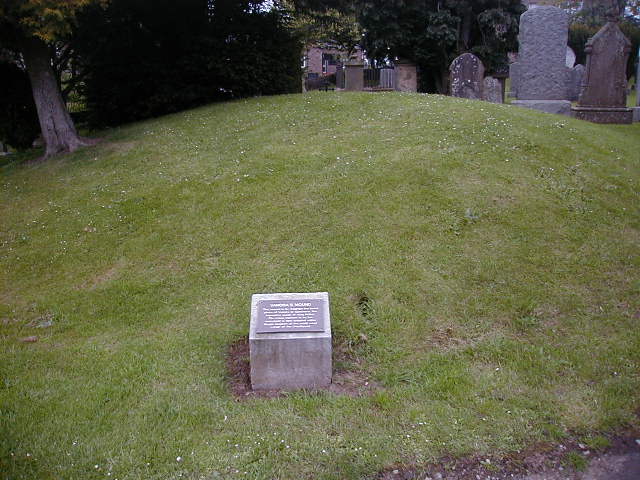
The stone has an imposing cross carved into its front face (below, left). According to legend, Vanora (Guinevere) was captured by Pictish King Mordred and held near Meigle. When she was released from enforced infidelity, King Arthur had her pulled apart by wild beasts. The back side of the stone (below, right) shows a series of figures, mostly on horseback at the top, and of mythical animals at the bottom. In the center panel, a robed figure is surrounded by four lions. Some experts say that this is a picture depicting the biblical story of Daniel in the lions' den. Others claim that it represents the execution of Vanora.
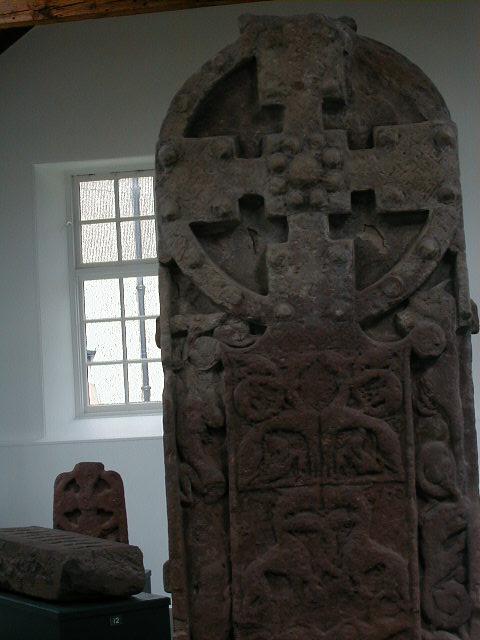
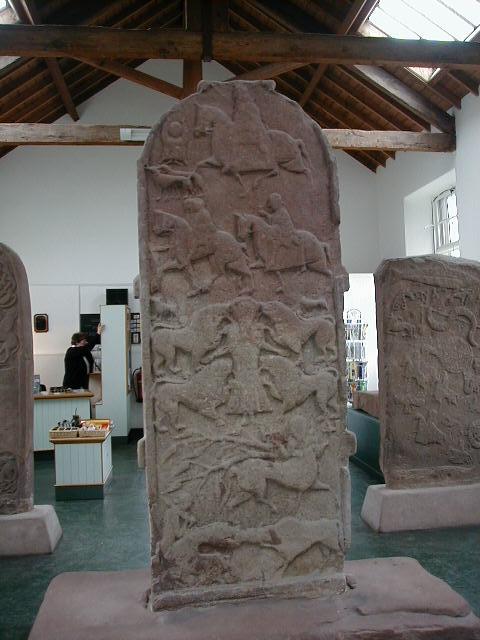
Most of the stones in the museum came from the Meigle churchyard and, from that, historians deduce that Meigle was a centre of some importance in the Pictish world. The presence of so many Pictish cross slabs suggests that a place of worship stood here as far back as the 8th or 9th centuries. Since then, there have been a succession of churches - each built on the same site to avoid disturbing the graves. The current church was built in 1869 after a fire destroyed its predecessor. Below are pictures of the current church's front (left picture) and its back (right picture). (The bald head appearing in front of the church doors belongs to the author who was married to Ms. Dale Morrison on June 8, 2000 in this church.)
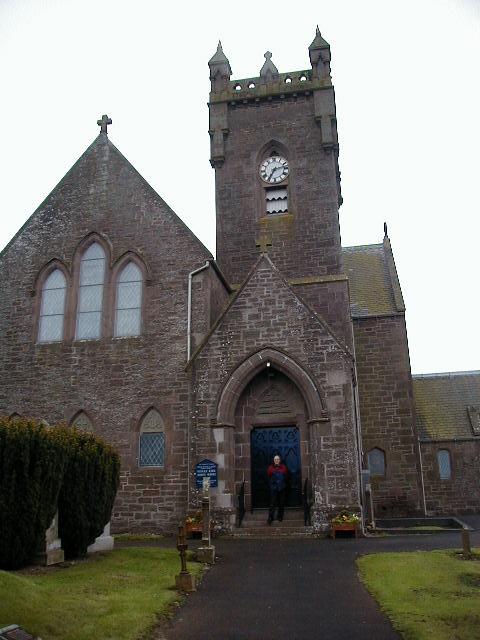
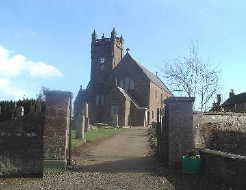
Meigle has had its place in history. In about 849 A.D. a Celtic scribe named Thana lived in Meggill and wrote the History of St. Regulus, also known as St. Rule. Later, in 1183, the income of the parish church of Meggill was granted by the Lord of the Manon, Simon de Meggill, to the Canons of the Priory of St. Andrews and later to the Bishops of Dunkeld, the ancient capital of McAlpin, King of the Scots. Another famous burial mound is found within the grounds of Belmont Castle just south of Meigle, where according to legend, Macbeth was killed by Malcolm MacDuff. Isabella MacDuff is purported to be buried within that mound. Belmont Castle, originally known as Kirkhill, was the residence of the ancient Bishops of Dunkeld, several of whom are buried in the churchyard. The castle was also the home of the Prime Minister of Britain, Sir Henry Campbell Bannerman from 1905 -1908.
The last image is of a map of east Perthshire showing the relative proximity of Dundee, Meigle and Alyth. Just north-east of Meigle, you can see the confluence of the Isla and Dean Rivers. This is the homestead site where our line of the Wighton family first lived in Scotland. (At least, as far back as we can determine.) Note also the proximity of Glamis, to the east. Glamis, the Queen Mother's castle, was the seat of the Earl of Strathmore with whom the Wighton family is associated. (Unfortunately, as landlord-tenant and not in a genetic way.) To get a sense of the scale, Alyth and Meigle are 3.5 miles apart. Dundee is about 12 miles away.
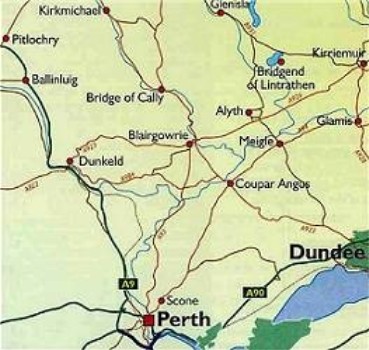
Sources
Various web sites, including
Meigle-History (http://www.scottish-towns.co.uk/perthshire/meigle/history.html)
Meigle Pictish Stones (http://www.undiscoveredscotland.co.uk/meigle/meiglestones/)
Places to Visit in Scotland: Meigle Museum (http://www.rampantscotland.com/visit/blvisitmeigle.htm)
Welcome to Meigle (http://www.scottish-towns.co.uk/perthshire/meigle/)